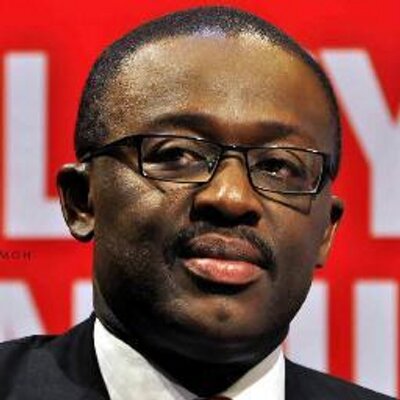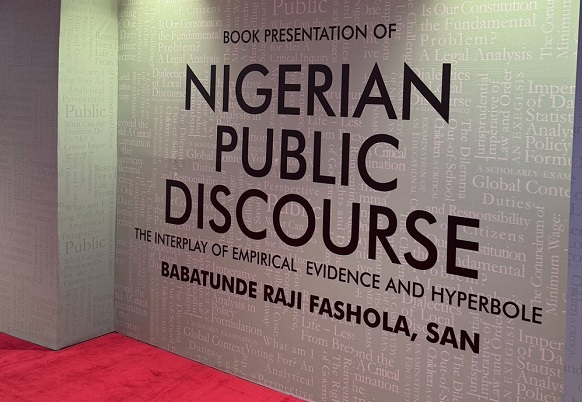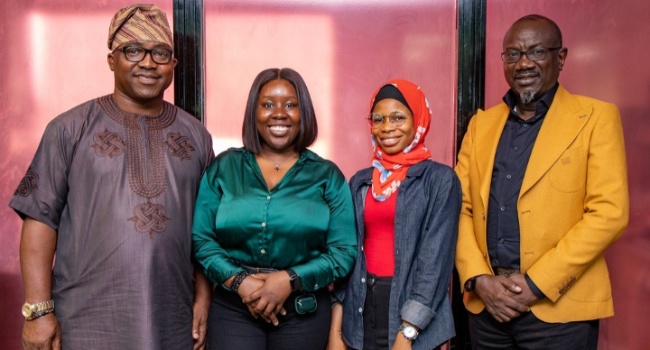BOOK REVIEW: Nigerian public discourse -- the interplay of empirical evidence, hyperbole
His Excellency Mr Babatunde Raji Fashola, SAN former Governor of Lagos State from 2007-2015 and Federal Minister of Works, Housing (and for four years, Power) from 2015-2023 has written a very insightful book. The theme of the book, titled “NIGERIAN PUBLIC DISCOURSE: THE INTERPLAY OF EMPIRICAL EVIDENCE AND HYPERBOLE” is to draw attention to the penchant for many Nigerians in public conversations to speak without empirical evidence (data) and consequently to engage in hyperbolic claims, i.e., grand exaggerations, often misleading the public.
The author sets the stage for the more serious policy-related hyperboles in the preface with several enduring but admittedly lighter myths-one of a legendary enmity between the Lagos Lagoon and Atlantic Ocean; another about a certain football match between Nigeria and India, which India won 90-0, obviously leveraging Indian magic; third, the story of Thunder Balogun, famed Lagos football striker blowing open the abdomen of an unnamed, unfortunate goalkeeper with one of his thunderous shots. While these examples, all complete fiction, may be mere “fabus” of entertainment value at worst, the author warns of the more serious consequences when tales of dubious origins are the basis of policy decisions. I quote him on page 3 of the text, “Governance is an earnest affair. Each government policy has the potential to profoundly impact the lives of citizens. Therefore, policy decisions must not be founded on assumptions, suppositions, or statistical facts of dubious origins.” In this quote and the thought process behind it, we see perhaps a hint of why Babatunde Raji Fashola was a successful public administrator-he thinks carefully about policy decisions; he seeks evidential support for the positions he takes before he takes them; and he is cognizant and apparently deeply so, of the impact of policy and governance on the citizenry.
I sympathize with His Excellency, as I have frequently experienced the issue the book draws attention to! Indeed, based on my experience, I could, with the author’s support, add “Myths and Fictions” to the title of the Book! Thus, the book might have appropriately been named, “Nigerian Public Discourse: The Interplay of Empirical Evidence, Hyperbole, Myths and Fictions”.
Let me illustrate this by drawing attention to one notorious myth that most people in this audience have probably listened and subscribed to, and that is the lamentation that “the groundnut pyramids have disappeared!” meant to communicate the fact of the diminution in Nigeria’s agricultural output! I instinctively wondered about how or why the ubiquitous pyramids disappeared until one day, over a decade ago, I decided to research the issue. My research did not last more than an hour before I found that there was possibly a very misleading myth! One of the advantages of teaching post-graduate students as I did at the time, and still do on an adjunct basis, was you could ask a large number of students to research your hunches and hypotheses, ethically and responsibly, of course. And that is what I did. I gave a term assignment in my Social, Political and Economic Environment of Business (SPEB) course to an MBA class to investigate and report on groundnut production in Nigeria and the phenomenon of groundnut pyramids. Every single one of my students found that groundnut production in Nigeria had increased significantly from the time of the pyramids! The pyramids were evidence, not necessarily of huge groundnut production, but of transportation and logistics deficiencies!!! The pyramids accumulated as the farmers and traders awaited the limited train and transport services that departed from Kano in Northern Nigeria to Lagos in Southern Nigeria. The disappearance of the pyramids was actually a sign of progress-increased transport and logistics options which led to faster evacuation and consumption of groundnut production. The second example might be the answers you will get, if you ask the average Nigerian, what percentage of the National Assembly’s budget is, of the national budget. The correct answer is of course 1.2% in the 2024 budget, and an average of 3% between 2007 to 2011!!!
Advertisement
These are the types of hyperboles, myths, unverified, unproven, and misleading claims, unsupported by accurate data, that the author, like the forensic advocate that he is, points out in this interesting and engaging book.
More Substantive Hyperboles and Myths
The author discusses a varied range of illustrations of his hypothesis in twelve (12) successive chapters of the book-Nigeria’s fiscal mechanisms relating to distribution of federation accounts; the link between law and order, values and perceptions of corruption in Nigeria; “The Imperative of Data and Statistical Analysis in Policy Formulation”; the dilemma of out-of-school children; Nigeria’s housing deficit; dimensions of poverty in Nigeria and the “myth” of One Dollar, A Day; the vexed issue of Nigeria’s electricity output; the “challenge of unfair comparisons” between Nigeria and other countries; a legal analysis of Nigeria’s constitution and whether the 1999 Constitution, as amended is our fundamental problem; the minimum wage “conundrum”; and the frills and cost of governance protocols.
Advertisement
Let us go through some of these hyperboles and myths to properly understand the author’s perspective!
In Chapter 1, HE Mr Fashola discusses an encounter with a Nigerian man in London, United Kingdon who wondered whether Nigeria had banks, based on his wrong understanding of the claim that the federation proceeded every month to Abuja to share money. This particular misunderstanding suggests that language, perhaps direct transliteration from indigenous languages into English, may play a role in this phenomenon– “won lo pin owo ni Abuja!” It also reveals that a second factor may be a lack of relevant contextual understanding. Anyone familiar with Nigeria’s financial sector would have known that FAAC proceeds are credited to state government accounts, after the FAAC meetings in Abuja.
The author’s theme in Chapter 2 is intricate. He argues correctly in my view that efforts to fight corruption in Nigeria have focused on the symptoms rather than the underlying causality, which he suggests is the lack of enforcement of law and order. In other words, our problem, he posits, is the absence of the rule of law, and consequently, the absence of consequences for corruption. This results in the “normalisation” of corruption and therefore a perception of higher levels of corruption. I think it is easy to agree as I have said with all the premises, but it seems there may be evidence that actual levels of corruption have indeed also risen significantly in Nigeria, between say the 1st and 2nd republics and the subsequent eras, even if you limit your data set to verified cases of corruption, such as the Abachas, Ibori, Alamieyesegha, Tafa Balogun and other cases, including federal accountant-generals and pension czars prosecuted by the EFCC and ICPC. The author also discusses the corruption of values which results in financial corruption, illustrating his point with several examples-inviting government officials to fundraisers; conferring chieftaincy titles on politically-exposed persons; deployment of young women as marketers by institutions; demanding two years rent from prospective tenants, amongst others. We can all agree that there might be a conscious or unconscious corrupt intent behind these actions.
In Chapter 4, HE Mr Fashola elucidates on the imperative of accurate data for effective policy and decision-making. He centres this discussion around Nigeria’s census and other important data sets such as employment. I must confess as someone who has to work with data and advise clients on economic, strategy and policy issues leveraging data, our population data gives me headaches, and I find myself oscillating between perceptions of credibility and incredibility from time to time. Until we conduct a fresh census, my advice is that users of population estimates and projections should try and relate the data to other data sets — NIN (104 million; 2023), BVN (60.2 million; January 2024) and electoral registers (93.36million; 2023). In relation to educational enrolment, for instance, I am in a position to assert with confidence, that many states inflate those figures for considerations of prebendal distribution of federal resources. The other implication is to urge HE the President of the Federal Republic of Nigeria to please ensure an accurate and credible census is conducted in the impending exercise.
Advertisement
The author discusses several other important issues relating to data accuracy in Nigeria-what is the correct number of out-of-school children in Nigeria? UNESCO (September 2022) says over 20 million; UNICEF (June 2022) suggests more than 18.3 million; The World Bank’s estimate (2020) is over 13 million. How can we devise correct policy solutions if we are not sure of our data? In addition to out-of-school children, I also worry about the quality of public education in-school children are receiving. What do data, including WASCE, NECO and JAMB results tell us about the quality of public education?
The author, having served as minister of housing for eight years carries out an informed analysis of Nigeria’s housing deficit. What is the correct housing deficit in Nigeria? I have wondered myself about the often-touted figure of 17 million units, which has appeared immutable for many years. As the author points out, it is not even clear what the source of the figure is; and his several attempts to cross-verify the data against alternative data sets (as I suggest with population) e.g., NBS household count and prevalence of vacant, unoccupied or under-occupied houses across Nigeria cast doubt on the data. Recent efforts by analysts at RTC Advisory Services provided varied answers including notable research by Euromonitor, Centre for Affordable Housing and PWC (2022) which estimates Nigeria’s housing deficit at 25-28 million units, up from 17 million in 2014-2015! Happily, the minister informs us that the proposed national census may include questions about housing and therefore shed light on the issue.
In Chapter 6, the author carries out a fine economic analysis of the “Myth of One Dollar a Day” as a measure of poverty in Nigeria and other developing countries, which he notes has been revised to $2.00 (or $1.90) a day, purportedly after the author challenged the basis of the one dollar per day assertion. Mr Fashola does not dispute the presence of poverty. He disputes the claim in the Brookings Institute Report on Global Poverty that Nigeria is the global capital of poverty, especially based on his comparisons with India. The World Bank’s Poverty Clock, which measures poverty on the $1.90 per day index, concluded that about 90 million people in Nigeria live in extreme poverty. We may note, that the threshold appears to have been recently revised upwards to $2.15. In criticising the report, the author notes that the report’s baseline was 2013, which therefore ignored “economic interventions” in 2014 and 2015; that the report used the General Household Survey 2012/2013 and not the Harmonized Living Standards Survey (because it was more recent and of higher quality); the report’s admission of the challenges in estimating poverty due to the “distinct differences” between Northern and Southern Nigeria; and the effects of civil unrest in Northern Nigeria.
I personally do not find these criticisms fatal to the credibility of the report. Indeed, every indicator points to the fact that poverty has worsened in Nigeria since 2014/2015 when oil prices fell precipitously (and thus government revenue and exchange rates worsened); and 2016-17, when Nigeria went into recession (and unemployment rose as economic activity declined); and again in 2020 with the COVID-19 pandemic, and lockdowns and ineffective welfare and palliative interventions, as well as a second recession within a five (5) year period. The author makes a related and, in my view, strong(er) argument about data neglecting“to factor in the disposable income of Africans and, particularly the Nigerian populace” based on our “socio-economic and cultural realities” such as extended family support system, which supports rent, school fees, medical bills, and sundry subsistence expenses. He also calls attention to the purchasing power parity of the Naira illustrating the cost of a meal and a bottle of Coca-Cola in Nigeria versus the USA. He thus calls for a comprehensive study that takes into account the African social support system in determining thresholds for estimating poverty. The author’s argument, which I have also made in my classes, has had real-world consequences, for instance during Nigeria’s GSM, (Digital Mobile Licence (DML) auctions in 2001. One reason I believe only African entities from South Africa, Zimbabwe and Nigeria sought and won those licenses is that Western telecommunications firms, focused exclusively on economic data, were not persuaded about the potential size of Nigeria’s telecommunications market. African companies, on the other hand, may have had the intuition to take our social environment into account! One question such a study might take into account however, will be whether the support system might be taken as income that obviates poverty or as a sort of indigenous welfare system that remediates poverty, much like official Western welfare systems are available to the poor.
Advertisement
In relation to multidimensional poverty, my understanding is that the concept seeks to distinguish between monetary poverty and deprivations regarding health, education and other indicators of standard of living. UNDP (2023) for instance, suggests that in Nigeria, multidimensional poverty is 2.1% higher than monetary poverty, implying persons above the monetary poverty line, may yet suffer severe deprivations.
There are several other important data-related debates in the author’s commendable contribution to public policy development– what is the correct quantity of electricity generated in Nigeria, not just on the national electricity grid? NERC’s own data affirms that the average available generation capacity declined from 4,712.34 MW in Q1 2022 to 4,211.44 by Q3 2023. How much electricity is generated off-grid from petrol and diesel generators, coal plants in cement factories, diesel and gas plants in our factories, solar power, and independent power producers across the country? He also raises questions about what he refers to as unfair comparisons between Nigeria and many smaller African countries. I do agree that appropriate context must be drawn when comparing Nigeria (GDP-$476.2Bn; Population-over 200million; National Budget-$49.39 2023) with Rwanda (GDP-$13.31; Population-13.8million; National Budget-$4.39Bn) or Ghana (GDP-$73.6BN; Population-34.1million). I recommend you buy and read the book to get a full understanding of the author’s rich and thoughtful perspectives!
Advertisement
I must discuss Chapter 9 in which the author examines whether the constitution is Nigeria’s fundamental problem, in some detail. He summarises his answer to this question early on as, “Nigerians want a better life, not a better document”. My question is, isn’t this statement true for Americans, Indians, British, Swiss, UAE, Brazilians, or even Chinese? Can’t they all be said to want a better life, and not necessarily a better constitution? Yet Americans, Indians, the British, the Swiss, Brazilians, Chinese and the UAE have devoted significant attention to designing a constitutional system that has facilitated their countries’ development. My second point is that design, good design is fundamental to efficient systems and outcomes, whether they be in architecture and construction, business strategy and business model design, innovation and product design in new product development, sociology and society, or constitutions and political systems. I think the argument for a better constitution alludes to the possibility of faulty design and therefore sub-optimal outcomes in our constitutional system, especially in the context of a diverse, multi-ethnic, multi-religious and large country like Nigeria. I also wonder what motives might underpin any agenda to increase unitarism and centralisation in Nigeria’s constitution design. What Nigeria’s history tells us is that such efforts might usually be motivated by a desire for hegemony, often with unwelcome or tragic consequences!
It is easy to agree with the author’s other perspectives that a constitution is not a “magic bullet” that solves all a nation’s problems; that our constitution is still significantly federal even though it contains several uncomfortably unitary elements; and that many of our most important challenges as a nation, for instance education and power retain significant scope for sub-nationals to intervene. I strongly endorse the author’s suggestion that one area of required constitutional reform may be the issue of state police. I think the core lesson from the author’s insights and argument is that calls for constitutional reform should go beyond rhetoric and posturing to reasoned arguments and justifications.
Advertisement
I do not intend to delve into the details of chapters 10, 11, and 12 dealing with the “conundrum of minimum wage”, duties and responsibilities of citizens, and the protocols of governance, which the author relates to the cost and time expended on governance. Suffice it to say that these add to the compelling arguments for accurate data, careful policy-making and reform that the author makes throughout the book.
Chapters 13-16 are essential reproductions of speeches previously made by the author- “What can the President do for me? A Critical Enquiry” (Chapter 13); “What am I voting for? An Analytical Perspective” (Chapter 14); “Restructuring for a Better Life-Lessons from BREXIT” (Chapter 15) and “Reinventing Nigeria: The Rights and Duties of Government and Citizens” (Chapter 16).
Advertisement
I was physically present at Yoruba Tennis Club on November 5, 2021, when “What can the President do for me?” was originally delivered. It was, in the author’s analytical and thoughtful style, an examination of Nigeria’s constitutional system and structure of powers. He points out for instance, that the president cannot sack policemen and civil servants; only the Police Service Commission and Civil Service Commission can do so! He notes, contrary to some assertions that the Vice President has substantive, constitutional responsibilities; he argues that the Nigerian constitution enshrines a system of shared powers and responsibilities between the federal and sub-national governments, exploring the exclusive and concurrent legislative lists. In a sense, I regard this speech as a precursor to the book.
The appendix to the book contains three items:
- Presentation of the Report of (Nigerian) Constitution Debate Coordinating Committee (CDCC) by Justice Niki Tobi
- Summary of Interventions of INEC in Electoral Activities of Countries in Africa
- Sample Report of Federal Road Safety Corps Road Traffic Crashes Monthly Report.
Concluding Thoughts
As I have said throughout this review, the author HE Mr Babatunde Raji Fashola has written a thoughtful, analytical and profound book seeking to correct hyperboles, deconstruct myths and destroy fiction around public policy in Nigeria. I think he does so very successfully.
In this his first effort at book authorship, Mr Fashola has made a very useful and important contribution. His central message is that we must base our public conversations and policy-making on accurate data and not myths, fiction and hyperboles. The book reminds us that the author took public administration very seriously and understood that if we base decision-making on no, or less-than-accurate data, the outcomes will be less-than-optimal or even disastrous. I call on government functionaries, public analysts and the media, who are the intermediaries of public commentary, to heed the author’s call, and in the specific case of the media, to elicit data underpinning public conversations and thus enhance the quality of public debate.
This book was published in 2023 by QuramoPublishing under its QBooks imprint. The foreword is written, very fittingly, by Alhaji Femi Okunnu, himself an eminent Lagosian, lawyer and SAN, and former Federal Minister of Works and Housing. Alhaji Okunnu in his brief comments appears to pine for a return to a more federal constitutional arrangement. The author dedicates the book to his family — his wife, our favourite first lady and my birthday mate; his children, parents, aunties and uncles, cousins, nephews and nieces, as well as in-laws, who bore the brunt of his over two decades in public service.
I commend HE Mr Babatunde Raji Fashola, SAN and the publishers (who I may note is led by another Lagos SAN, Olasupo Shashore, both fellow Old Igbobians), for an undoubtedly worthy contribution to enhancing Nigerian Public Discourse and commend the book to all Nigerians in government and public service, private sector, media, academia, policy analysis and social sciences, especially economists and students of public administration and public policy. Indeed, every educated Nigerian will benefit from reading this book.
Thank you very much for listening.
Opeyemi Agbaje is a consultant on strategy, economy and policy, and management. An author and academic, he wrote the authoritative newspaper column, “Economy, Polity, Society” in Businessday for over a decade and a half. He is Founder/CEO of RTC Advisory Services Ltd and adjunct faculty in Strategy at the Lagos Business School. One of his books is titled, “The BRF Era: Policy and Governance in Lagos State 2007-2015” published in 2015.







